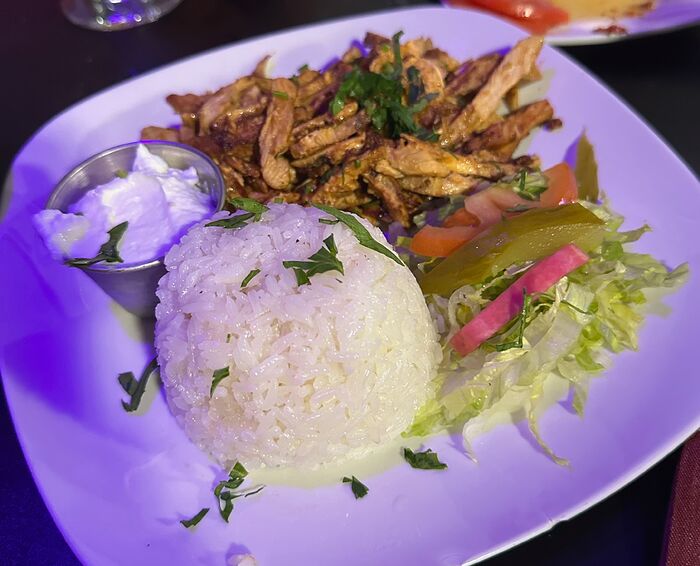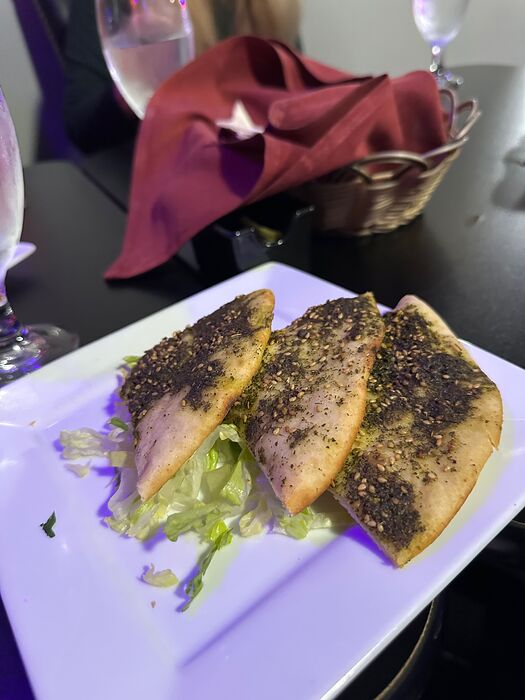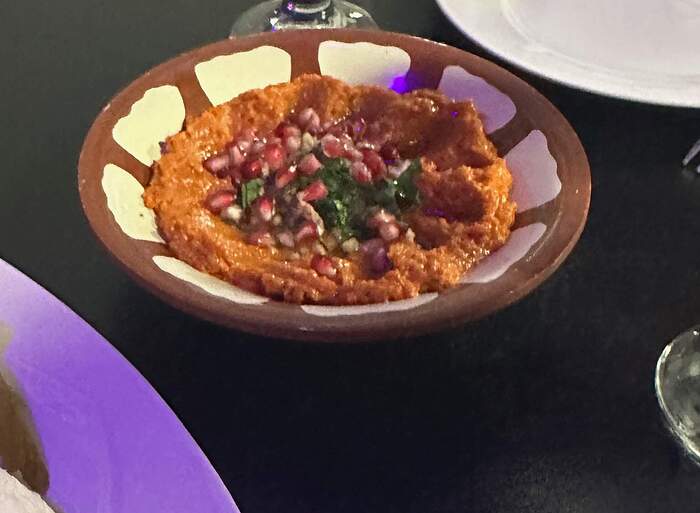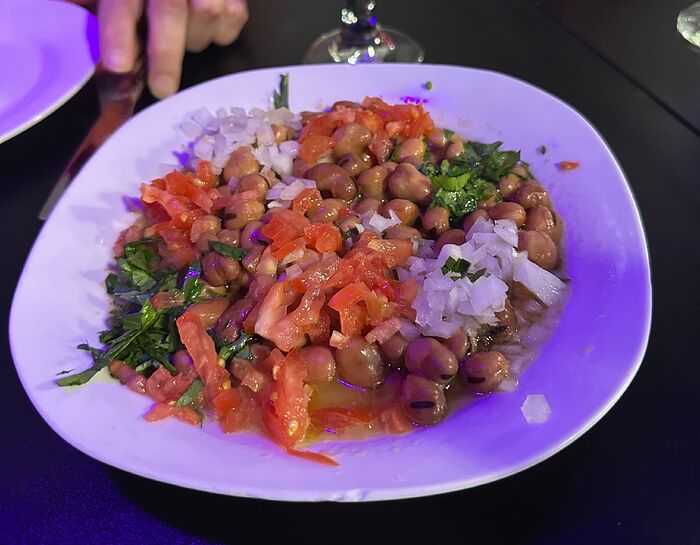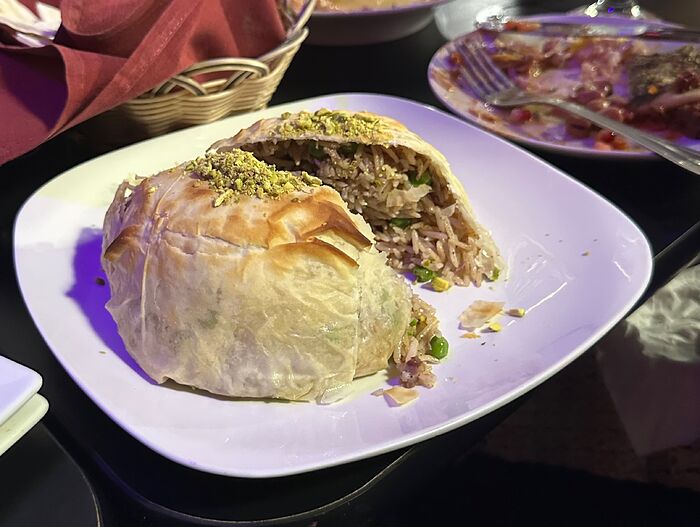This is going to be too long and too pretentious, but here goes.
I’ve often said that one meal at a restaurant is only a single data point, so I tend to get my back up a little when someone declares a restaurant bad based on a single meal. But that’s because restaurants naturally vary from day to day or even from dish to dish.
It’s unusual, however, for me to be in a group of people where opinions differ widely about the same meal, unless there is an unusually picky eater in the group.
I recently ran across a cool saying (ChatGPT attributes it to Islamic and Jewish tradition, derived from the Talmud (Sanhedrin 37a) and the Koran (5:32)), “Whoever destroys a single soul, destroys an entire world.” We all bring our own worlds with us, so I guess I shouldn’t be surprised when perceptions differ so radically about a single meal, as they did for me and at least some of the others at this meal, which I really enjoyed a lot.
I’ll start with Steve’s negative reaction to the old incarnation of the predecessor restaurant, Layalina. When Layalina first opened back in 1997, it was a huge hit for our family. Although it billed itself as a Lebanese restaurant, it was very different from our old Lebanese stand-bys like the Lebanese Taverna, seeming more like home-cooking with dishes like lamb shanks.
Layalina was always wonderfully friendly and welcoming, especially the co-owner, who we always thought of as “the mom.” Layalina was a favorite of ours for several years, but over time it seemed to fade and become more standardized and we gradually stopped going. This seemed to coincide with the disappearance of the mom from this family-owned restaurant (maybe she got busy with raising kids?).
But the warm memories of the early Layalina lingered, so I was delighted when our server said that Alshami is a recreation of Layalina and that she was “the mom.” I was prepared to love the meal right from the start, even before they brought any food out.
I did a little googling and found an old article about the first year of Layalina. https://www.fcnp.com/2007/10/24/restaurant-spotlight-layalina-restaurant/#:~:text=Layalina%20Restaurant%20opened%20in%201997,pieces%20of%20Middle%20Eastern%20artwork.
The name of “the mom” is Rima. She’s Lebanese and her husband and co-owner is Syrian, which explains the re-branding of the restaurant as Syrian this go-round. I haven’t spent a ton of time in the Levant – about 10 days in Lebanon and 3 days in Jordan – but from my experience there really aren’t any major national differences in the cuisine of the Levant (not counting Israel, whose cuisine is significantly different). There is a lot of variation from restaurant to restaurant, of course, but trying to distinguish between “Lebanese cuisine” in general and “Syrian cuisine” in general seems unrealistically precise. So the new designation of Alshami as “Syrian” probably tells more about the owners’ perception that Americans now value novelty in food more now than they did in 1997 than it does about any real difference in the cuisine.
I do have some areas of agreement with Maureen’s and Steve’s negative reviews, or at least areas where I don’t disagree:
(1) The purple lighting was awful for photos. I managed to salvage only a few photos.
(2) While I can’t say for sure that the pita was bad, it did look store-bought so I didn’t eat any of it.
(3) The most heinous vegetable in existence is stewed okra, whether prepared in American southern style, Indian style, or West African style. I guess it’s conceivable that Levantine stewed okra is good, but in practice I just go, “I say it’s stewed okra and to hell with it.” I didn’t touch the bamia.
(Before I get too much pushback, I will concede that fried okra is good, but deep-fried tire treads would probably be good too. And of course, gumbo is a whole different thing.)
So no comment from me on whether the bamia was too similar to the other dishes with a tomato sauce.
(4) I’m disqualified from commenting on the eggplant fatteh, since I’m lactose-intolerant and yogurt is a primary ingredient. So I can’t resolve the difference between Steve’s blah review (“serviceable”) and Maureen’s somewhat more favorable response.
(5) The beef shawarma was delicious (as was the chicken shawarma), so I’m line with Steve, Maureen, and Caroline on that. I confess I didn’t even notice whether the way the beef was cut was unusual. My impression is that it’s usually cut into strips, but I could be wrong. Certainly, chicken shawarma is usually cut into strips (and that’s what we do when we make it at home). These were excellent versions of shawarma (but not as good as the truly ambrosial shawarma at Haifa Grill in Falls Church).
(Sorry for the purplish tinge on the photo of the chicken shawarma.)
(6) I don’t think I tasted the lubia (green beans), just because the logistics didn’t work out, so no comment on that one either.
Now, on to the areas of disagreement.
(1) I guess the biggest difference is just the gestalt of the meal. I enjoyed just about every dish I tried, from start to finish, and I kept telling David, “Man, this is really good,” over and over. I will definitely be back to Alshami and soon.
(2) No one really discussed the manakish with zaatar, which I thought was one of the highlights of the meal. I love zaatar and thought this rendition was quite good. It’s possible that no one else commented on it because I hogged most of it for myself.
(3) There wasn’t much comment on the muhammara, which I guess falls into Steve’s residual “serviceable” category. Toni and I first had muhammara at al-Mandi, a famous restaurant in a Christian neighborhood of Madaba, Jordan, and fell in love with it. Toni’s made it many times since then and we always seek it out in restaurants.
This version was delicious, but, to be fair, it usually is (the only version of muhammara I can remember having that was substantially different from the standard versions was at Maydan in DC; that version was sweeter and smoother, but not as much to my taste as the “standard” versions). I certainly wouldn’t call it merely “serviceable,” though; the connotations of that are too negative for a very good dish.
(Sorry for the fuzziness of the pic; I guess I can’t blame the purple light for that.)
(3) I loved the sujuk (and probably ate way more than my fair share). The tomatoes could have been canned, but to me that’s not a criticism at all. There are a lot of excellent canned tomatoes on the market (and Marcella Hazen actually recommends using canned tomatoes in her famous pasta sauce with onion and butter).
I also don’t think it’s fair to criticize the dish for not being the usual grilled preparation you see with sujuk or for being “overcooked” because it was stewed and crumbly. If chefs are afraid to deviate from the norm, you end up with repetitious menus like those that you now see at virtually all mainstream Thai restaurants in the US.
So, probably my strongest difference with Steve’s review is his statement that “You should not misidentify soujouk as muhammara” – partly because I don’t think there should be any “thou shall not’s” with food and partly because it didn’t resemble the muhammara at all.
I can’t comment on whether the tomato sauce was too similar in the sujuk, lubia, and bamia, since I only had one of the three. But did we ask Rima to make suggestions about whether we were ordering dishes that were too similar?
(4) As for the foul, it was obviously a non-standard preparation, as foul is ordinarily pureed very smooth. I’m not sure “deconstructed” foul is a good idea, but I only had one bite so I hesitate to be definitive about that.
I had only one bite not because of the taste, but because it was very sloppy to eat (I tried to pile it on a piece of manakish, but it fell everywhere). Ordinarily, I don’t mind sloppy food (as you can tell by my clothes at the end of a meal), but I had one of my worst travel experiences as a result of sloppy foul.
When we were in Amman, we wanted to eat at Al Hashem, the most famous foul place in the country – the king reportedly ate there often. But it was unexpectedly really cold in March, so we mentioned to our Jordanian host at the B&B that I was going to buy a cheap jacket before heading to the foul place. Our gracious host insisted that I take his jacket, which turned out to be a super-nice leather jacket, with a finish that was almost buttery. I protested (the jacket had to have cost more than a thousand dollars), but it seemed pretty clear that he would be offended if I did not wear the jacket.
I managed to find a cheap nylon jacket, and then headed over to Al Hashem. But it was quite cold and Al Hashem is in an alley with outdoor seating at awkward low tables. I made the terrible mistake of not switching to my nylon jacket and managed to immediately drop my first bite of foul (with a layer of glistening olive oil) onto my host’s expensive leather jacket, creating a huge stain.
I have rarely been as embarrassed as I was telling our host I had ruined his jacket. Of course, I offered to pay for it, but he politely lied that it could be cleaned and waved away my offer. I felt (and still feel) terrible about that.
So, anyway, sloppy foul is a no-go for me.
(5) I also really enjoyed the ouzi, which I thought was very rich and full of “umami.” I agree that it was not as good as the similar Kurdish dish at Erbil, but that was in an elevated category of its own. The version at Alshami was very good and certainly did not seem either cold or plain. Possibly our differing perceptions were because Steve, Maureen, and Toni had one ouzi and our end had another ouzi – or possibly I’m just an easily pleased floozie when it comes to food. In either case, I liked the ouzi and would recommend it to others.
(6) Finally, the makdous. I’d never heard of this dish, so I was really glad that Steve ordered it off-menu. I had no expectations for what it would be like, but was delighted to find that the eggplant was pickled (I didn’t pick up any lemon taste, unlike Steve), and the walnuts made it unlike anything I’ve had before (unlike Caroline I thought the two tastes were complementary). Along with the manakish, this was one of the highlights of the meal for me.
Of course, the company was great too.
Sorry to be out of sync with some of the others, but differences of opinion are what make horse races.
Doug
